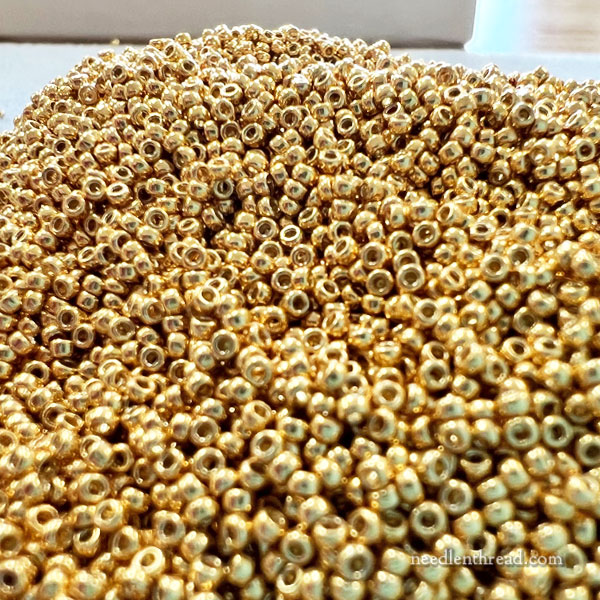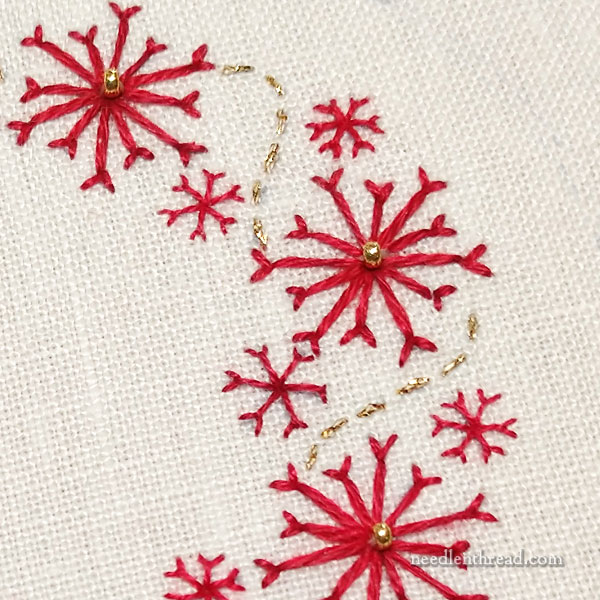We’ve been weighing mountains of beads here in the studio.
When assembling supplies for kitting, I buy beads in bulk and then we break them down into little packages based on weight. I’ve written about weighing beads here, if you want to read about how we do it.
I’ve mentioned this before, but I want to make a distinction in types of embroidery involving beads. The way I see it, “embroidery with beads” implies that you’re working an embroidery project that involves beads, usually as accents. The majority of the work is regular embroidery with thread, and the beads are added for a bit of sparkle and zing.
On the other hand, “bead embroidery” is a type of embroidery that is worked with beads, and beads pretty much make up, or are involved in, the majority of the project.
For the most part here at Needle ‘n Thread, it works like this: I embroider, and I happen to accent some of it with beads, especially when creating festive ornaments and the like.
So I call it “embroidery” … with beads.

One of the important parts of kitting any embroidery project is determining amounts of things to include in kits. You might think that beads would be especially difficult to figure out, but that’s the great thing about them. They’re not!
Beads are sold by weight, usually by grams.
With most brand beads – like Miyuki or Toho – you can find out from the manufacturer or from distributors how many beads are normally in a gram. The smaller the bead, the more there are per gram.
The two common sized beads I use for accenting embroidery are 15/0 and 11/0 beads. I can look up how many round 15/0 seed beads are normally in a gram of Miyuki beads. The average is about 250.
For 11/0 round seed beads, there are approximately 109 beads per gram. For 11/0 Delica beads, the average is 193 beads per gram.
When you’re only using beads as an accent in embroidery, then, you can see that, in one gram of beads, you have a pretty good quantity of beads to bling up your embroidery!

If you only use 7 or 8 beads to accent an ornament, think of how many ornaments or small projects you could embellish with one gram of 15/0 seed beads. Over 25!
On the retail market, beads are usually sold in larger packages or tubes – say, 7 grams or more. But when we are kitting up for small projects, it makes sense to kit smaller quantities in order to help keep the cost of the kit reasonable. If we were kitting, say, six types of beads in a kit, and we kitted with larger containers of pre-packaged beads, the retail cost of the beads alone in the kit could range from around $18 – $30 or more, depending on the bead and the pre-packaged sizes available. And that’s just for beads! That doesn’t include thread, fabric, finishing supplies, and other kit contents.
So it makes sense to weigh out smaller quantities that provide enough beads to accent with. This way we can avoid a massive price increase on kits for projects that really only require a handful of beads to make them festive.
And that’s what we’re doing today – finishing up 3,600 little packages of beads for your entertainment!
We know how to have fun!
It is fun, in its own cozy little way: it’s cold outside, warm inside, we’ve got an audiobook going, and the kettle is always ready with hot water for the occasional tea break. What’s not to love?
I hope you have a lovely weekend! I’ll be stitching away on the last little bits of this collection of projects, which I can’t wait to share it with you in November!
More on Embroidery with Beads
You can find a collection of tutorials featuring embroidery with beads here, if you’re looking for some ways to apply beads to your stitching.







There IS something rewarding about running your fingers through piles of beads! Looking at all the color and sparkle! It is, however, truly a labor of love!!! Thanks to Mary and her Crew!
I have to admit, it’s hard to resist playing with the piles! You’d be surprised the myriad ways you can mold piles of beads. And yes, running your fingers through them is somewhat akin to dipping into a pirate’s treasure chest, on a tiny scale!
Hi Mary,
Another unsolicited suggestion: I’d try to convert weight to volume.
E.g. Measuring out and packaging 1/8th or 1/4th teaspoons is significantly faster than weighing. Time is money.
I understand you’d have to initially convert each type bead.
Btw. When you figure out your conversion it is much more accurate to do it with e.g. the equivalent of 10 or 20 times the portion amount vs trying to do it on a single portion.
If your needed volume is an odd number that is far from an easily obtainable item, like baking measuring spoons, there are ways that you can easily make your own with stuff you have laying around. Feel free to contact me and I’ll explain.
Cheers,
Regina
Hi, Regina – oh trust me, we have tried that over and over and over again, but there is simply too much variation using volume measurements. We can’t even get a decent “average,” the range is so great each time we’ve tested various volume measurements. It’s not easy to level beads in a teaspoon (or half a teaspoon…). We’ve even tried taking the weight we want and fitting it into a specially formed and sized “scoop” – but again, the range of difference each time we scoop makes it prohibitive. With weight, we know exactly how much we have, how much we need to order (beads are sold by weight, not volume), and what’s left in our inventory. We can also price things much more accurately.
Wow! Do you make these 3600 kits only for one project? No wonder you’re so busy!
Aaaaaack! LOL! It’s not 3600 kits. There are multiple bags of beads in each kit.
whew.